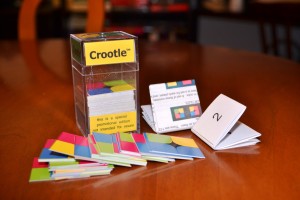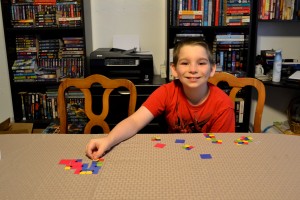“Crootle”, put simply, tasks players with matching colored tiles in an attempt to form a path from one end of the board to the other. Sounds simple, right? Well, yes and no. While being able to match colors is a skill that we learn at a very young age, the manner in which players place the tiles will ultimately determine who wins and who loses. I have weakness for games that are easy to play but involve a bit of critical thinking and strategic planning…to that end, “Crootle” certainly fits the bill. Before we get started with the preview, I’d like to thank the folks at World Village Games, LLC for providing me with a prototype copy. As with most prototypes, it’s important to stress that they usually aren’t representative of the final product. The content in the pictures featured below are therefore subject to change.
The game comes in a pretty compact package, consisting of corner tiles, color tiles, and the Tree Saver Game Board. Corner tiles are solid in color, consisting of red, blue, green, or yellow. These tiles are used to set up the game, as well as determine which colors players will be aiming to connect on the board. Color tiles are made up of multiple colors and will be the playing pieces players will use to connect the corner tiles together in order to win the game. The Tree Saver Game Board, as the name implies, is a slip of paper with numbers on it ranging from one to sixteen. Its sole purpose is to measure the distance between the four corners of the square-shaped playing grid when setting up the game.
With the above in mind, the game is a cinch to set up. First, you’ll need to separate the corner tiles into sets (four tiles of one color each). The board will receive a face-down set and every player will likewise receive a face-down set. Players will then unfold the Tree Saver Game Board and stretch it across the table horizontally and vertically, placing the board’s set of face-down corner tiles in the four corners of the square-shaped playing grid. In the default game, tiles will be placed this way below/above the one and sixteen, though I see no reason why you couldn’t live a little and set your own distances…just be sure that in the end, the corners outline a perfect square. Once the corner tiles are in place, they are flipped over. Players randomly choose two corner tiles from their own set, discarding the other two, and flip them over. Finally, each player receives ten random color tiles, face up.
At this point in time, players will know which two colors they’ll need to connect (as represented by their face up corner tiles). On a player’s turn, they’ll place as many color tiles as they can on the board. In order to place a tile, it’ll need to make sense in that all sides / quadrants match the colors of existing tiles already on the board. The kicker? Players can only build off of the corner colors that they have in front of them. For example, if a player has red and blue corner tiles, they’ll only be permitted to place color tiles off of the red and blue corners of the board. They are not permitted to place tiles and build paths on the green and yellow corner tiles. Needless to say, things can get messy if every player ends up picking the same set of corner tiles.
If a player manages to use all of the tiles on their turn, they’ll get to draw another five to use immediately. This can only occur once on a player’s turn. After the first round of turns is complete, players will draw five tiles (not ten) at the beginning of every turn. What’s more, turns are timed…though I found the rules to be flexible in that regard. Players will need to think and act fast in order to make the most of their turn before the time limit expires. The first player to connect the two corners they need (as represented by the corner tiles in front of them) wins the game! Keep in mind that I overviewed the rules…if you’d like to see them in greater detail, please check out the official website via the link below. The rules also include a few variants to mix things up, so I highly recommend checking them out!
“Crootle” turned out to be pretty darned intense, despite its simplicity. I found that a player’s strategy changes significantly depending on which two corner tiles the other players receive. If players end up with two very popular colors, the obvious “connect the two corners as fast as you can” strategy goes out the window. Rather, you will need to pay attention to what your opponents are doing and try to time your tile placements in a way that would ensure that you could swoop in and make the connection at the last second. “Crootle” is a very fast, very family-friendly experience that you won’t soon forget. Its quick play time makes it perfect for nights where you just don’t have a lot of time to play a longer game. The suggested / estimated retail price is about fourteen dollars, though that number may change as the game is still in the early stages of development. To that end, this is one game that you’ll want to keep an eye on, especially if you’re a parent to younger children who are often left out because they can’t handle more complex games.
—
The “Crootle” is currently being funded through Kickstarter (as of 8/21/13). You can learn more about and support the game by visiting the following websites:
http://www.kickstarter.com/projects/crootle/crootletm-a-card-game-of-kaleidoscopic-proportions
http://crootle.com/official-rules/


